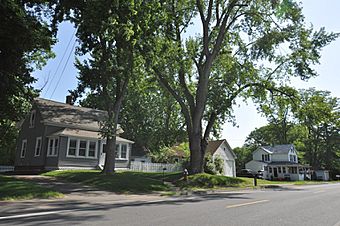Elm Street Historic District (Hatfield, Massachusetts) facts for kids
Quick facts for kids |
|
|
Elm Street Historic District
|
|

Bungalow-style houses on Elm Street
|
|
| Location | Elm Street, southern Hatfield, Massachusetts |
|---|---|
| Area | 561 acres (227 ha) |
| Architectural style | Georgian, Federal |
| NRHP reference No. | 00001481 |
| Added to NRHP | December 7, 2000 |
The Elm Street Historic District is a special area in southern Hatfield, Massachusetts. It's like a living museum that shows how people lived and farmed there for hundreds of years. This district includes old fields, some still used for growing tobacco, and many historic buildings.
A historic district is a group of buildings, sites, or objects that are important because of their history or architecture. The Elm Street Historic District was added to the National Register of Historic Places in 2000. This means it is officially recognized as a place worth protecting for future generations.
What is the Elm Street Historic District?
This historic district covers a large area of about 561 acres. It includes land along five main roads: Elm Street, Scotland Road, Sunset Road, Brook Hollow Road, and Little Neponset Road. The district is bordered by the Connecticut River to the south and the Mill River to the east and north.
It also touches two other historic areas. To the northeast, it meets the Mill–Prospect Street Historic District. To the east, it connects with the Hatfield Center Historic District. The western edge of the district is near the meeting point of Elm and Dwight Streets.
A Look at the Buildings
Most of the buildings in the Elm Street Historic District are either homes or farm buildings. You can see many old houses that show different building styles from over the years. Most of these homes were built before the 1940s.
The district also has important farm buildings. These include large barns used for drying tobacco. Tobacco farming has been a big part of the area's history for a long time.
A Glimpse into History
Hatfield was first settled in the mid-1600s. It officially became a town in 1670. The land along Elm Street was originally used by everyone in the community for farming. In 1683, plots of land were set aside for building houses.
Growth in the area was slow at first. But after the United States became independent, more buildings started to appear. Unlike the town center, which was richer, the Elm Street area had simpler homes. These houses were often built for farm workers.
Small businesses also grew here, like making brooms. Tobacco became a very important crop, which led to many tobacco barns being built. In 1900, a trolley line was built on Elm Street. This made it easier to travel to Northampton and helped the area grow even more in the early 1900s.



